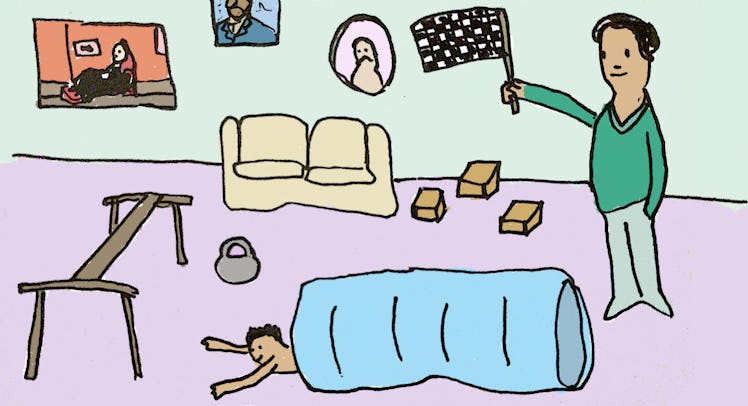How to Make a Great Living Room Obstacle Course
It doesn't have to be a Tough Mudder for kids to have fun and get some much-needed exercise.

Long before obstacle-course races became the dad fitness fad du jour, kids enjoyed crawling, jumping, and swinging from station to station in PE class. And they still do, even if not all of them want to train for a Mini Mudder. Most young kids have a good notion of what obstacle courses are (the world looks like one when you’re small enough) so getting them to race through homemade gauntlets is fairly easy and, when it comes to tiring them out, incredibly effective. It’s one of the great activities for kids that naturally builds on itself because kids will want to provide feedback on specific obstacles and courses can have endless permutations, at least until someone breaks something. The perfect obstacle course should be challenging, silly, and easily deconstructed or reconstructed. But, most importantly, it should be safe ⏤ so no fire pits!
Prep Time: About 30 minutes.
Entertainment Time: 20 minutes to two hours.Energy Expended by Child: Mostly physical, unless you want to throw in a puzzle or two.
What You Need:
- Things to jump over, onto, or from. Interlocking foam play mats and tumbling mats are great. So are ropes, toys, cushions, and very stable pieces of furniture.
- Things to crawl under or through. If you don’t already have a play tunnel, pull a sheet taut and have them crawl under it, army style.
- Things to throw. Make a station where aim is important. Throwing is a skill very young kids can develop.
- Things to balance on. An extra piece of woods in the shed can be a balance beam. So can a floorboard if everyone agrees it’s surrounded by lava.
- If you’re setting an outdoor obstacle course up in the backyard, there are plenty of ready-to-buy obstacles, as well.
How to Play:
The best way to play ‘Obstacle Course’ is by building several stations, each with their own challenge. Depending on the age of the kids, they can help with this part. Here’s an example (note that writing it down can be helpful and make comprehension part of the game):
- Balance beam.
- Knock down all the cans.
- Jump from block to block.
- Ride the tricycle across the living room while making a silly face.
- Crawl through the tunnel.
- Drag a heavy thing past the line.
- Walk a ping pong ball with a spoon.
The individual stations can be anything and are only limited by space and imagination. You can add special challenges as kids figure out how to manage certain obstacles. It’s also important to note that stations can reoccur in each running of an obstacle course. It is, for instance, a great idea to get kids to jump multiple times between activities that require more precise muscle control. This forces kids to engage different muscles and tires them out.
It’s also important to note that obstacle course are not merely physical. They are based on rules. It’s good to establish a points system that informs timing (plus 10 seconds for falling off the balance beam) because it incentivizes kids to really do the thing while turning you into a referee and arbiter of success, which puts you in a better position to encourage certain approaches or dish out positive feedback so kids feel like they’re making progress over time. If they aren’t, it also puts you in a prime position to obscure that fact.
To that end, it’s smart to make yourself one of the obstacles. Make kids dodge balls you’re throwing, chase you down, or play the levels game. This allows for you to make the course increasingly difficult and gets you directly involved, which is likely to ramp up interests (kids are predictable like that). On that same note, it’s a good idea to try to do the course — the parts you can fit through — to set a baseline time for your kid to beat. A bit of competition, no matter how silly, provides kids with a way to compete with mom and dad and understand their abilities and bodies in relation to other people’s. This leads to an ability to do a kind of athletic self-assessment that can be helpful later in life. It also tends to lead to absolute exhaustion.
Wrap Up:
Obstacle courses are a great way for your kids to burn off excess energy. And if they ever get tired of the same old course, change the theme or turn it into a narrated adventure: Superhero tryouts, ninja training, find the hidden treasure. Younger kids will especially enjoy embarking on the course as a character on an expedition. In the end, not only is it satisfying to watch your kids challenge themselves but also to watch them enjoy something you all built … even if it was made with couch cushions.
